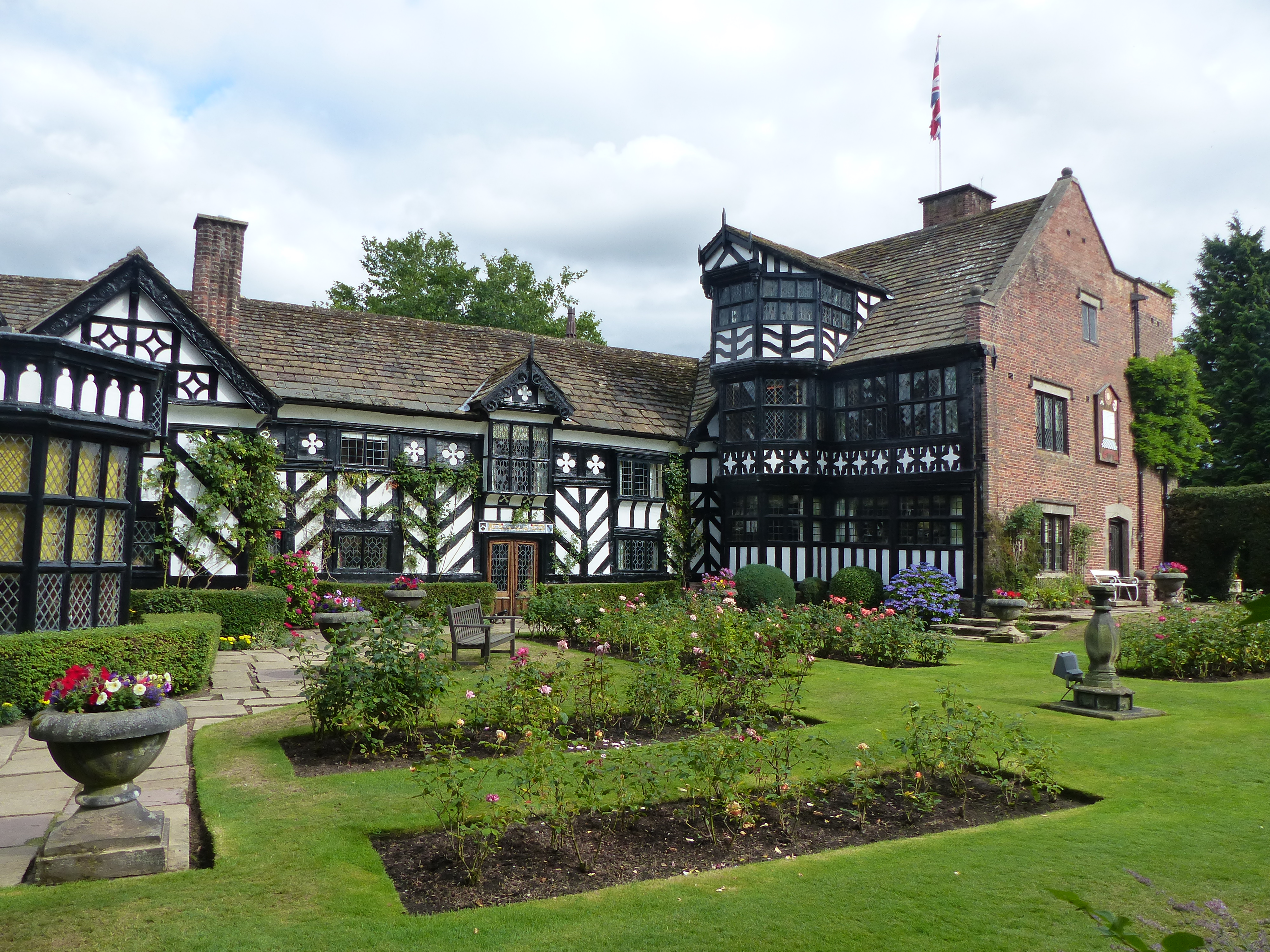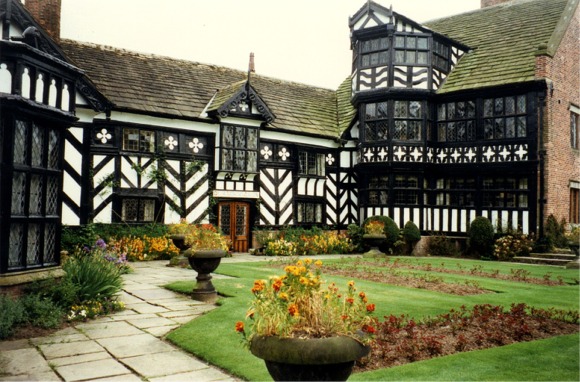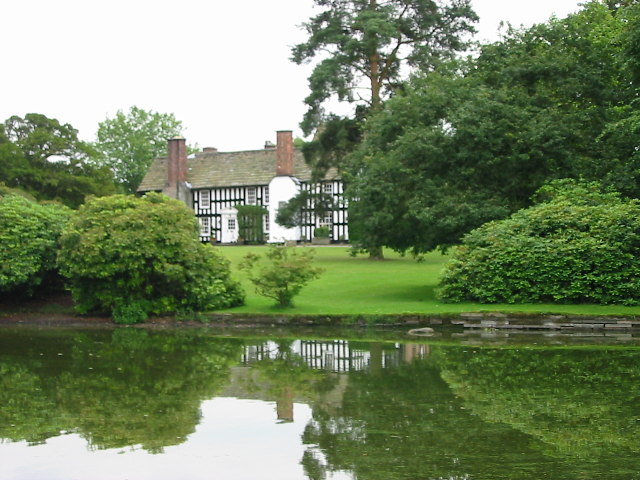|
Old Rectory, Gawsworth
Gawsworth Old Rectory is a medieval house in the village of Gawsworth, Cheshire, England. It is known for the rare survival of its " open hall" and the notable 1873 restoration by Richard Norman Shaw, and is recorded in the National Heritage List for England as a designated Grade I listed building. The Old Rectory was described as "an exceptionally fine timber-framed house" by Nikolaus Pevsner. History Gawsworth Old Rectory was built as a rectory in c.1470 by the Gawsworth rector George Baguley, for the opposite St. James' Church. Sir Thomas Fytton (Fitton), of nearby Gawsworth Old Hall served as Baguley's patron, and may have helped to finance the rectory's construction. A dedicated inscription to the Fitton family exists built into one of the fireplaces. The house was restored first in c.1724 by rector William Hall, and then famously the second time in 1873 by the architect Richard Norman Shaw. The house served as a rectory to St. James' Church until 1953, when ... [...More Info...] [...Related Items...] OR: [Wikipedia] [Google] [Baidu] |
Middle Ages
In the history of Europe, the Middle Ages or medieval period lasted approximately from the late 5th to the late 15th centuries, similar to the post-classical period of global history. It began with the fall of the Western Roman Empire and transitioned into the Renaissance and the Age of Discovery. The Middle Ages is the middle period of the three traditional divisions of Western history: classical antiquity, the medieval period, and the modern period. The medieval period is itself subdivided into the Early, High, and Late Middle Ages. Population decline, counterurbanisation, the collapse of centralized authority, invasions, and mass migrations of tribes, which had begun in late antiquity, continued into the Early Middle Ages. The large-scale movements of the Migration Period, including various Germanic peoples, formed new kingdoms in what remained of the Western Roman Empire. In the 7th century, North Africa and the Middle East—most recently part of the Eastern Ro ... [...More Info...] [...Related Items...] OR: [Wikipedia] [Google] [Baidu] |
George Baguley
George Baguley was the Rector (ecclesiastical), rector of St James' Church, Gawsworth, St James' Church, in Gawsworth, Cheshire, from 1470 to his death in 1497. The knight Sir Thomas Fytton (Fitton) of Gawsworth Old Hall served as Baguley's Patronage, patron. This enabled Baguley to build the Gawsworth Old Rectory about 1470. Baguley's date of birth is unknown. An original manuscript belonging to Baguley, containing prayers and musical notations, was passed to the rector of Tredington, Warwickshire, Tredington, William Durham, and in turn to the celebrated bishop and academic Thomas Barlow (bishop), Thomas Barlow (1607–1691). Barlow bequeathed Baguley's manuscript to the Bodleian Library of Oxford, where it remains in the collection of medieval manuscripts. References {{DEFAULTSORT:Baguley, George 15th-century English Roman Catholic priests 1497 deaths Year of birth unknown People from Cheshire (before 1974) ... [...More Info...] [...Related Items...] OR: [Wikipedia] [Google] [Baidu] |
Houses In Cheshire
A house is a single-unit residential building. It may range in complexity from a rudimentary hut to a complex structure of wood, masonry, concrete or other material, outfitted with plumbing, electrical, and heating, ventilation, and air conditioning systems.Schoenauer, Norbert (2000). ''6,000 Years of Housing'' (rev. ed.) (New York: W.W. Norton & Company). Houses use a range of different roofing systems to keep precipitation such as rain from getting into the dwelling space. Houses may have doors or locks to secure the dwelling space and protect its inhabitants and contents from burglars or other trespassers. Most conventional modern houses in Western cultures will contain one or more bedrooms and bathrooms, a kitchen or cooking area, and a living room. A house may have a separate dining room, or the eating area may be integrated into another room. Some large houses in North America have a recreation room. In traditional agriculture-oriented societies, domestic animals such as ... [...More Info...] [...Related Items...] OR: [Wikipedia] [Google] [Baidu] |
Grade I Listed Buildings In Cheshire
The county of Cheshire is divided into four unitary authorities: Cheshire West and Chester, Cheshire East, Warrington, and Halton. As there are 142 Grade I listed buildings in the county they have been split into separate lists for each unitary authority. * Grade I listed buildings in Cheshire West and Chester * Grade I listed buildings in Cheshire East * Grade I listed buildings in Warrington * Grade I listed buildings in Halton (borough) See also * Grade I listed churches in Cheshire * Grade I listed non-ecclesiastical buildings in Cheshire * Grade II* listed buildings in Cheshire The county of Cheshire is divided into four unitary authorities: Cheshire West and Chester, Cheshire East, Warrington, and Halton. As there are 390 Grade II* listed buildings in the county, they have been split into separate lists for each un ... {{GradeIListedbuilding * * ... [...More Info...] [...Related Items...] OR: [Wikipedia] [Google] [Baidu] |
Listed Buildings In Gawsworth
Gawsworth is a civil parish in Cheshire East, England. It contains 20 buildings that are recorded in the National Heritage List for England as designated listed buildings. Of these, three are listed at Grade I, the highest grade, two are listed at Grade II*, the middle grade, and the others are at Grade II. Apart from the village of Gawsworth, the parish is rural. The most important buildings in the parish, all listed at Grade I, are Gawsworth Old Hall and associated structures, St James' Church, also with associated structures, and the Old Rectory. Listed at Grade II* are Gawsworth New Hall and an associated barn. The Macclesfield Canal runs through the parish, and there are three listed structures associated with this, two bridges and a milestone. The other listed buildings are houses, farm buildings, a grave, a public house, a war memorial, and a boundary stone. Key Buildings See also *Listed buildings in Bosley * Listed buildings in Henb ... [...More Info...] [...Related Items...] OR: [Wikipedia] [Google] [Baidu] |
Grade I Listed Buildings In Cheshire East
There are over 9,000 Grade I listed buildings in England. This page is a list of these buildings in the unitary authority of Cheshire East. Listed buildings Notes See also * Grade I listed buildings in Cheshire ** Grade I listed buildings in Cheshire West and Chester ** Grade I listed buildings in Cheshire East ** Grade I listed buildings in Warrington ** Grade I listed buildings in Halton (borough) *Grade II* listed buildings in Cheshire The county of Cheshire is divided into four unitary authorities: Cheshire West and Chester, Cheshire East, Warrington, and Halton. As there are 390 Grade II* listed buildings in the county, they have been split into separate lists for each un ... References External links {{DEFAULTSORT:Cheshire East * ... [...More Info...] [...Related Items...] OR: [Wikipedia] [Google] [Baidu] |
Close Studding
Close studding is a form of timber work used in timber-framed buildings in which vertical timbers ( studs) are set close together, dividing the wall into narrow panels. Rather than being a structural feature, the primary aim of close studding is to produce an impressive front.Looking at Buildings (Pevsner Architectural Guides): Close Studding (accessed 20 October 2017) Close studding first appeared in England in the 13th century and was commonly used there from the mid-15th century until the end of the 17th century. It was also common in France from the 15th century. Description Although close studding is defined by the distance between the vertical timbers, the spacing used is variable, up to a maximum o ...[...More Info...] [...Related Items...] OR: [Wikipedia] [Google] [Baidu] |
Timber Framing
Timber framing (german: Holzfachwerk) and "post-and-beam" construction are traditional methods of building with heavy timbers, creating structures using squared-off and carefully fitted and joined timbers with joints secured by large wooden pegs. If the structural frame of load-bearing timber is left exposed on the exterior of the building it may be referred to as half-timbered, and in many cases the infill between timbers will be used for decorative effect. The country most known for this kind of architecture is Germany, where timber-framed houses are spread all over the country. The method comes from working directly from logs and trees rather than pre-cut dimensional lumber. Hewing this with broadaxes, adzes, and draw knives and using hand-powered braces and augers (brace and bit) and other woodworking tools, artisans or framers could gradually assemble a building. Since this building method has been used for thousands of years in many parts of the world, many styles ... [...More Info...] [...Related Items...] OR: [Wikipedia] [Google] [Baidu] |
Gawsworth - Parish Church
Gawsworth is a civil parish and village in the unitary authority of Cheshire East and the ceremonial county of Cheshire, England. The population of the civil parish at the 2011 census was 1,705. It is one of the eight ancient parishes of Macclesfield Hundred. Twenty acres of the civil parish were transferred to Macclesfield civil parish in 1936 The country houses Gawsworth Old Hall, Gawsworth New Hall and Gawsworth Old Rectory are in the village. The authors of the Cheshire volume of the ''Buildings of England'' series state: There is nothing in Cheshire to compare with the loveliness of Gawsworth: three great houses and a distinguished church set around a descending string of pools, all within an enigmatic large-scale formal landscape. A wood near the village known as Maggotty Wood is the burial place of the eighteenth-century dramatist Samuel "Maggotty" Johnson. His ghost is reputed to haunt the wood. Governance Gawsworth Parish Council consists of 9 elected Councillors in ... [...More Info...] [...Related Items...] OR: [Wikipedia] [Google] [Baidu] |
Fitton Baronets
The Fitton Baronetcy, of Gawsworth in the County of Chester, was a title in the Baronetage of England. It was created on 2 October 1617 by James I for Edward Fitton, of Gawsworth Hall, Gawsworth, Cheshire. The Fitton family were settled in Gawsworth from about the 13th century. The first Baronet's ancestors included Sir Edward Fitton (1500–1553), High Sheriff of Cheshire in 1544 and Sir Edward Fitton (1527–1579), Treasurer of Ireland and President of Connaught. His father Sir Edward Fitton (1548–1606) was an unsuccessful colonist of Munster. His sister, Mary Fitton, was Maid of Honour to Elizabeth I. The second Baronet, High Sheriff in 1633, was an officer in the service of Charles II and was briefly Governor of Bristol following that city's fall during the English Civil War. The baronetcy became extinct on his death in 1643. He left his estate by his will of 1641 to his Irish cousin William Fitton of Awne (Awrice), County Lim ... [...More Info...] [...Related Items...] OR: [Wikipedia] [Google] [Baidu] |
Patronage
Patronage is the support, encouragement, privilege, or financial aid that an organization or individual bestows on another. In the history of art, arts patronage refers to the support that kings, popes, and the wealthy have provided to artists such as musicians, painters, and sculptors. It can also refer to the right of bestowing offices or Benefice, church benefices, the business given to a store by a regular customer, and the patron saint, guardianship of saints. The word "patron" derives from the la, patronus ("patron"), one who gives benefits to his clients (see Patronage in ancient Rome). In some countries the term is used to describe political patronage or patronal politics, which is the use of state resources to reward individuals for their electoral support. Some patronage systems are legal, as in the Canadian tradition of the Prime Minister to appoint Senate of Canada, senators and the heads of a number of commissions and agencies; in many cases, these appointments go to ... [...More Info...] [...Related Items...] OR: [Wikipedia] [Google] [Baidu] |
Gawsworth Old Hall
Gawsworth Old Hall is a Grade I listed building, listed English country house, country house in the village of Gawsworth, Cheshire, England. It is a timber-framed house in the Cheshire black-and-white style. The present house was built between 1480 and 1600, replacing an earlier Norman architecture, Norman house. It was probably built as a courtyard house enclosing a Quadrangle (architecture), quadrangle, but much of it has been demolished, leaving the house with a U-shaped plan. The present hall was owned originally by the Fitton family, and later by the Gerards, and then the Stanhopes. Since the 1930s it has been in the possession of the Richards family. Raymond Richards collected a number of items from other historic buildings and incorporated them into the hall. Notable residents have included Mary Fitton, perhaps the "Shakespeare's sonnets#The Dark Lady, Dark Lady" of Shakespeare's sonnets, and Samuel Johnson (dramatist), Samuel "Maggoty" Johnson, a playwright des ... [...More Info...] [...Related Items...] OR: [Wikipedia] [Google] [Baidu] |






_(31023042187)_CROP.jpg)
